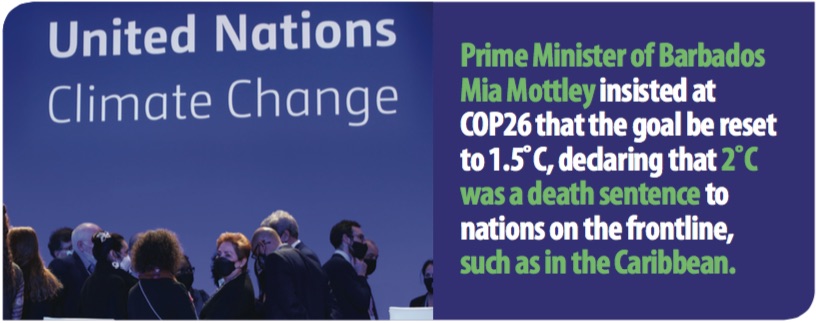In 2018, the Intergovernmental Panel on Climate Change (IPCC) reported on the difference half a degree can make on the effects of warming.
The Paris Agreement had resulted in countries committing to keep global warming below 2˚C (3.6˚F) while trying to limit temperature increase to 1.5˚C (2.7˚F). Prime Minister of Barbados Mia Mottley insisted at COP26 that the goal be reset to 1.5˚C, declaring that 2˚C was a death sentence to nations on the frontline, such as in the Caribbean.
According to the IPCC report, “The world has already witnessed about 1˚C of temperature rise and is on track to exhaust the carbon budget associated with 1.5˚C by 2030.”

The World Resources Institute compiled this breakdown of the differences between a 1.5˚C and a 2˚C world, based on the IPCC report. Here are some of the projections.
Temperatures: Average and extreme temperatures will be higher in all inhabited areas under 2°C of warming versus 1.5°C. Under 1.5°C, almost 14 per cent of the world’s population would be exposed to severe heat waves at least once in five years. Under 2°C, it would be 37 per cent.
Sea Level Rise: With 1.5°C of warming, sea level rise would be 0.4m in 2100, compared to levels in 1986-2005. At 2°C, it would be 0.46 m (Dr Hugh Sealy thinks this is an underestimation.) The risk of flooding increases, affecting 69 million people at 1.5 and 79 million at 2°C.
Species Loss: At 2°C, 18 per cent of insects globally, 16 per cent of plants and eight per cent of vertebrates are projected to lose more than half of their ranges. At 1.5°C, this is reduced by two-thirds for insects, and by half for plants and vertebrates. Other factors that lead to losses of species, such as forest fires and the spread of pests and diseases, also decrease if warming stays at 1.5°C.
Transformed Ecosystems: At 2°C, 13 per cent of the Earth’s land area is projected to witness biome shifts (such as changing from tundra to forest), or transformation, as compared with four per cent at 1.5°C. Ocean ecosystems are already transforming and will change dramatically with just 1.5°C of warming.
Coral reefs are projected to decline by 70–90 per cent with warming greater than 1.5°C. With an additional half degree of warming, more than 99 per cent losses are expected. Loss of fishery productivity at low latitudes, acidification, dead zones and other dangerous conditions are projected to be more pronounced. One study cited in the report found that the global annual catch from marine fisheries declined by 1.5 million tons under 1.5°C of warming. Under 2°C, that loss grew to 3 million tons.
Food shortages, health issues, economic hardship, increased flooding and drought are among the areas to be significantly affected by just half a degree more of warming.
